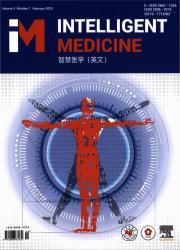基于通用空间模式算法的手部运动和运动图像功能近红外光谱信号分类精度提高
IF 6.9
Q1 COMPUTER SCIENCE, INTERDISCIPLINARY APPLICATIONS
引用次数: 0
摘要
目的利用功能近红外光谱(fNIRS)对运动图像任务进行分类是脑机接口(BCI)研究中的一个重大挑战,因为fNIRS信号具有高维性质。本研究旨在通过使用公共空间模式(CSP)算法来降低支持向量机(SVM)和线性判别分析(LDA)分类器的输入维数来解决这一挑战。方法收集15名健康右撇子志愿者的数据,包括左手运动、左手运动想象、右手运动和右手运动想象。利用来自20通道fNIRS的信号,输入特征包括均值、方差、斜率、偏度和峰度等统计描述符。将CSP算法集成到支持向量机和LDA分类器中进行降维。统计方法主要包括分类精度评价和比较。结果平均值和斜率是最具判别性的特征。在没有CSP的情况下,SVM和LDA分类器的平均准确率分别为59.81%±0.97%和69%±11.42%。然而,与CSP集成后,SVM和LDA的准确率分别显著提高到81.63%±0.99%和84.19%±3.18%。该值表示SVM和LDA分类器的准确率分别提高了21.82%和15.19%。支持向量机实现了从100维降至25维,降低了计算复杂度,加快了计算速度。此外,CSP技术将LDA分类器在运动和运动图像任务中的准确率提高了3.31%。结论CSP算法的集成对BCI系统的性能有很大的改善潜力。本文章由计算机程序翻译,如有差异,请以英文原文为准。
Improvement of classification accuracy of functional near-infrared spectroscopy signals for hand motion and motor imagery using a common spatial pattern algorithm
Objective
Classifying motor imagery tasks via functional near-infrared spectroscopy (fNIRS) poses a significant challenge in brain-computer interface (BCI) research due to the high-dimensional nature of the signals. This study aimed to address this challenge by employing the common spatial pattern (CSP) algorithm to reduce input dimensions for support vector machine (SVM) and linear discriminant analysis (LDA) classifiers.
Methods
Data were collected from 15 healthy right-handed volunteers performing tasks involving left-hand motion, left-hand motor imagery, right-hand motion, and right-hand motor imagery. Signals from 20-channel fNIRS were utilized, with input features including statistical descriptors such as mean, variance, slope, skewness, and kurtosis. The CSP algorithm was integrated into both SVM and LDA classifiers to reduce dimensionality. The main statistical methods included classification accuracy assessment and comparison.
Results
Mean and slope were found to be the most discriminative features. Without CSP, SVM and LDA classifiers achieved average accuracies of 59.81 % ± 0.97 % and 69 % ± 11.42 %, respectively. However, with CSP integration, accuracies significantly improved to 81.63 % ± 0.99 % and 84.19 % ± 3.18 % for SVM and LDA, respectively. This value represents an increase of 21.82 % and 15.19 % in accuracy for SVM and LDA classifiers, respectively. Dimensionality reduction from 100 to 25 dimensions was achieved for SVM, leading to reduced computational complexity and faster calculation times. Additionally, the CSP technique enhanced LDA classifier accuracy by 3.31 % for both motion and motor imagery tasks.
Conclusion
Integration of the CSP algorithm may demonstrate promising potential for improving BCI systems' performance.
求助全文
通过发布文献求助,成功后即可免费获取论文全文。
去求助
来源期刊

Intelligent medicine
Surgery, Radiology and Imaging, Artificial Intelligence, Biomedical Engineering
CiteScore
5.20
自引率
0.00%
发文量
19
 求助内容:
求助内容: 应助结果提醒方式:
应助结果提醒方式:


